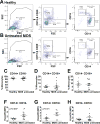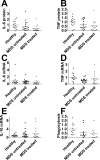Monocyte function in patients with myelodysplastic syndrome
- PMID: 29656609
- PMCID: PMC6113098
- DOI: 10.1002/JLB.5AB1017-419RR
Monocyte function in patients with myelodysplastic syndrome
Abstract
Myelodysplastic syndrome (MDS) is a malignant hematopoietic stem cell disorder that frequently evolves into acute myeloid leukemia (AML). Patients with MDS are prone to infectious complications, in part due to the presence of severe neutropenia and/or neutrophil dysfunction. However, not all patients with neutropenia become infected, suggesting that other immune cells may compensate in these patients. Monocytes are also integral to immunologic defense; however, much less is known about monocyte function in patients with MDS. In the current study, we monitor the composition of peripheral blood monocytes and several aspects of monocyte function in MDS patients, including HLA-DR expression, LPS-induced inflammatory cytokine production, and phagocytosis. We find that monocytes from MDS patients exhibit relatively normal innate immune functions compared to monocytes from healthy control subjects. We also find that HLA-DR expression is moderately increased in monocytes from MDS patients. These results suggest that monocytes could compensate for other immune deficits in MDS patients to help fight infection. We also find that the range of immune functions in monocytes from MDS patients correlates with several key clinical parameters, including blast cell count, monocyte count, and revised International Prognostic Scoring System score, suggesting that disease severity impacts monocyte function in MDS patients.
Keywords: LPS; PBMC; human leukocyte antigen-antigen D related; myelodysplastic syndrome; phagocytosis.
©2018 Society for Leukocyte Biology.
Conflict of interest statement
Figures



Similar articles
-
Monocyte-Derived Macrophages Are Impaired in Myelodysplastic Syndrome.J Immunol Res. 2016;2016:5479013. doi: 10.1155/2016/5479013. Epub 2016 Dec 15. J Immunol Res. 2016. PMID: 28074192 Free PMC article.
-
Differential Expression of CD52, CD14 and HLA-DR on CD4+ Monocytes in Three Types of Acquired Bone Marrow Failure Syndromes.Clin Lab. 2016 Sep 1;62(9):1767-1772. doi: 10.7754/Clin.Lab.2016.160211. Clin Lab. 2016. PMID: 28164595
-
Bone Marrow Monocytes and Derived Dendritic Cells from Myelodysplastic Patients Have Functional Abnormalities Associated with Defective Response to Bacterial Infection.J Immunol. 2020 Apr 15;204(8):2098-2109. doi: 10.4049/jimmunol.1900328. Epub 2020 Mar 16. J Immunol. 2020. PMID: 32179638
-
Surface marker abnormalities in myelodysplastic syndromes.Haematologica. 1998 Dec;83(12):1104-15. Haematologica. 1998. PMID: 9949628 Review.
-
High Ia (HLA-DR) and low CD11b (Mo1) expression may predict early conversion to leukemia in myelodysplastic syndromes.Am J Hematol. 1993 Jul;43(3):165-71. doi: 10.1002/ajh.2830430302. Am J Hematol. 1993. PMID: 8352230 Review.
Cited by
-
Myelodysplastic syndrome-associated spliceosome gene mutations enhance innate immune signaling.Haematologica. 2019 Sep;104(9):e388-e392. doi: 10.3324/haematol.2018.214155. Epub 2019 Mar 7. Haematologica. 2019. PMID: 30846499 Free PMC article. No abstract available.
-
Computational analysis of peripheral blood smears detects disease-associated cytomorphologies.Nat Commun. 2023 Jul 20;14(1):4378. doi: 10.1038/s41467-023-39676-y. Nat Commun. 2023. PMID: 37474506 Free PMC article.
-
Distinct bone marrow immunophenotypic features define the splicing factor 3B subunit 1 (SF3B1)-mutant myelodysplastic syndromes subtype.Br J Haematol. 2021 May;193(4):798-803. doi: 10.1111/bjh.17414. Epub 2021 Mar 25. Br J Haematol. 2021. PMID: 33765355 Free PMC article. Clinical Trial.
-
MDS-associated SF3B1 mutations enhance proinflammatory gene expression in patient blast cells.J Leukoc Biol. 2021 Jul;110(1):197-205. doi: 10.1002/JLB.6AB0520-318RR. Epub 2020 Nov 6. J Leukoc Biol. 2021. PMID: 33155727 Free PMC article.
-
Expression of mRNA TNFα and level of protein TNFα after exposure sCD40L in bone marrow mononuclear cells of myelodysplastic syndromes.Stem Cell Investig. 2021 Mar 29;8:6. doi: 10.21037/sci-2020-025. eCollection 2021. Stem Cell Investig. 2021. PMID: 33829058 Free PMC article.
References
-
- Tefferi A, Vardiman JW. Myelodysplastic syndromes. The New England journal of medicine. 2009;361:1872–85. - PubMed
-
- Barzi A, Sekeres MA. Myelodysplastic syndromes: a practical approach to diagnosis and treatment. Cleve Clin J Med. 2010;77:37–44. - PubMed
-
- Garcia-Manero G. Myelodysplastic syndromes: 2011 update on diagnosis, risk-stratification, and management. American journal of hematology. 2011;86:490–8. - PubMed
-
- Corey SJ, Minden MD, Barber DL, Kantarjian H, Wang JC, Schimmer AD. Myelodysplastic syndromes: the complexity of stem-cell diseases. Nat Rev Cancer. 2007;7:118–29. - PubMed
-
- Sekeres MA. The epidemiology of myelodysplastic syndromes. Hematology/oncology clinics of North America. 2010;24:287–94. - PubMed
Publication types
MeSH terms
Substances
Grants and funding
LinkOut - more resources
Full Text Sources
Other Literature Sources
Medical
Research Materials
Miscellaneous

